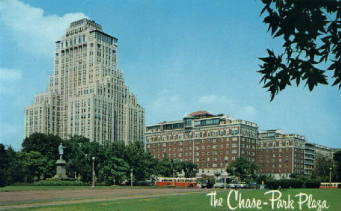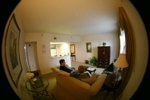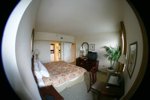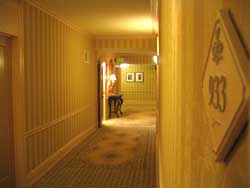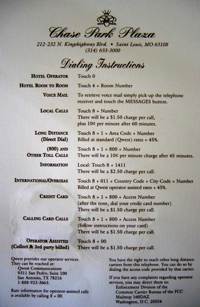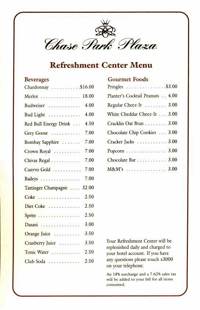
|
|
|
Wednesday 29 September 2004
Chase Park Plaza Hotel, St. Louis The Chase Park Plaza is the nicest hotel we stayed in on our recent trip, and it’s definitely in the running for the nicest hotel we’ve ever stayed in. As it happens, I used to live in this hotel. The ‘Chase Park Plaza’, as it now styles itself, used to be the ‘Chase-Park Plaza’. The ‘Chase’ part included large ballrooms, restaurants, and so forth, and lots of furnished rooms that were rented by the night. The ‘Park Plaza’ was mainly an apartment building, though some apartments could be rented by the night. Whether you were there for a week or a year, and whether or not you brought your own furniture, you could get maid and linen service, room service, etc. through the hotel. This is apparently now considered some revolutionary thing that Ritz-Carlton is doing, and it gets written up on the front page of the Wall Street Journal. Anyway, in this old postcard, the Chase is the 12-story red brick building on the right, and the Park Plaza is the 27-story stone building on the left:
When I lived there, the Chase was closed down after years of neglect. The apartments had been renovated and the Park Plaza was mostly occupied, but the Chase was completely empty and kind of spooky. It was no trouble to get into the building, and if you had the foresight to bring a flashlight with you, there were all kinds of interesting things to see. For decades, if you were a president, a king, a tycoon, etc. and you came to St. Louis for some reason, the Chase-Park Plaza was the place to stay. Most modern hotels are just a warren of identical rooms, but not this place. So since I lived there, the Chase has been renovated, and it now once again operates as St. Louis’ primary swank hotel. It looks to me like the investors hedged their bet a bit by renovating the building in such a way that it could be used either for apartments or hotel rooms: this is the only hotel room I’ve ever been in that had a walk-in closet and a washer and dryer in it. It’s a very nice, and very comfortable hotel.
Absent were the usual horrible plastic ‘Vellux’ blankets, the fluorescent lights, and the funky smell that I’m used to in hotels. The laminate on the cheap kitchen cabinets was coming off, and there was only a lamp on one side of the bed — both of these I consider to be serious problems in a place of this caliber — but generally the things that really mattered were done right. The blankets involved either down or some very high-quality polyester fiberfill business. The pillows were of differing firmnesses, something I haven’t seen before in a hotel. Most good hotels offer a few different kinds of pillows, but I am strange in that I require three very different kinds of pillows in order to get a good night’s sleep. The Chase Park Plaza supplied them by default. As I said, the things that really matter were done right. Mostly. The exceptions were things that all ‘four-star’ hotels seem to get wrong: that is, things that are easy or simple or reasonably-priced in cheaper accomodations but that become horrible ordeals, or unbelievably expensive, in a place where you’re paying more for your room to begin with. I consider hotel ice to be one of the world’s chief luxuries. I have no idea how this came to be part of the American hotel tradition, but I have never stayed in a hotel in the United States that was so mean that it did not supply its guests with an unlimited supply of high-quality ice, on the house. Every room is equipped with an ice bucket, and every floor with one or more commercial ice machines that churn out vast quantities of perfect ice, 24 hours a day. This is even true of hotels where each room has an icemaker-equipped refrigerator, as did ours at the Chase. Everyone knows that the ice out of the dedicated machines is superior to that quasi-cylindrical garbage you get from refrigerator icemakers. Anyway, the Chase Park Plaza, being a class place, has equipped its floors with ice makers. But because it’s a nice place, they undoubtedly thought that putting these noisy stainless-steel machines out in the open would spoil the ambience: so they put them in little rooms near the elevators. You can see one of these little rooms standing open in this picture:
The room is standing open because the doors are equipped with the same locks as on the guest room doors. That is, if a guest gets his ice and then closes the door, subsequent guests can’t get any ice, because the hotel’s management hold the only keys that will re-open the door. This is insane. To get into this hallway in the first place, you have to have a key. If you don’t stick your keycard into the slot in the elevator, the elevator won’t move. Why on earth they ever thought that it might necessary for you to further prove your status as a guest before getting ice, I don’t know. Why they then have the locks programmed to actually not open for guests is a further mystery. During one of the many calls I made to the front desk to get them to come unlock the ice door, I asked them about this: the person on duty there had no idea why it was possible to lock up the ice, or why the doors won’t open for guest keycards. Now, admittedly, on the scale of human tribulation, having to call the front desk of a fancy hotel in order to get some ice doesn’t even really get the needle to move off the peg. But the Chase Park Plaza, in addition to being a fancy hotel, is an expensive one. I have never had to call anyone at a Motel 6 or a Holiday Inn to get ice. When I am paying for premium service, I expect to have this kind of thing managed for me; I do not appreciate paying for the privilege of being part of the Chase Park Plaza’s the-ice-door-is-locked alert system. And speaking of paying for premium service: it is strange but true that the more you pay for a hotel room, the more likely you are to be nickel-and-dimed to death once you’re inside. I suppose that this is because the hotel people believe — probably correctly — that people saying in $59-a-night rooms are pretty cost-conscious and will balk at small additional charges, while people paying hundreds of dollars a night are more likely to be either on an expense account or personally wealthy enough not to care that you’re charging them $1.50 for each local phone call. Here’s the Chase Park Plaza’s phone rate card, which Nicole used as a coaster before I got a picture of it. Clicking on the image will pop up a bigger version: This is all pretty standard for a hotel of this kind; it’s not like the Chase Park Plaza’s charges are at all out of the ordinary. They charge $1.50 for each local call, and ‘regular’ (read: high) long distance rates plus 45% for long-distance calls. Should you be so insane as to want to make an overseas call from your hotel room, they charge you operator-assisted rates — for an unassisted call — plus 45%, plus whatever kickback they get from Qwest for swinging such an account their way. Ladies and gentlemen, I give you the ‘hospitality’ industry. They use the word ‘guest’ pretty liberally, but when you scratch the surface you’re reminded that even after you’ve checked in they’re trying to squeeze you, and they’re trying pretty ineptly, too. I understand that people don’t run hotels out of the goodness of their hearts, and that they’ve got to make money. I further understand that hotel phone systems are in fact fairly complicated and expensive things to operate: but this is just nuts. I should pay them for a single call 2.5% of what I pay for a whole month’s service on my cell phone? No, thanks. They might be basing their charges on some kind of analogy to the cost of the hotel room. They rent for about $6,000 a month a hotel room that would rent for, at most, $1,000 a month as an apartment. The phone call they charge $1.50 for can be had at any coin phone for $0.25, again 1/6 the price. The trouble is that they forget that people do not carry portable, battery-operated apartments around in their pockets. They must make money this way; after all, the entire hotel industry can’t be run by morons. But I wonder whether they wouldn’t make more money by not trying to gouge the hell out of their guests once they’re inside. Oh, and they charge you an additional $10 a day, $20 a week, or $40 a month for their wireless Internet service, which is pretty ineptly provided. You’ve got to re-authenticate every time you turn your computer on (or wake it from sleep), and we had to call the technical support number — which is nowhere to be found in the room, you have to call someone else just to find out what it is — twice to get them to reset something when their system couldn’t cope. Oh yeah, and the tech support line is not in the hotel, which means you’re paying $1.50, or using your cell phone, when you have a problem. You could use the computers and printers in the ‘business center’ in the basement, but this is somewhere around $40 an hour, and $1.60 per page printed. Copies cost about the same, or several thousand percent more than at Kinko’s or any other place where the same services are available. Sure, there’s some convenience to the guest to having that in the hotel, but the Chase Park Plaza has chosen to take the entire benefit of that convenience as a cash payment from the guest, and none of it as guest goodwill as a result of the hotel being more convenient. So it’s not more convenient in the end — something that might have figured in to the fact that during our week there, we never saw a single person using the hotel’s business center. In the same vein, consider this ‘refreshment center menu’. ‘Refreshment center’ means some things that they stick in the fridge and leave on the counter in the kitchen. Click on the little image to get a bigger one: There are at least three things wrong here:
Again, there’s some convenience in having this stuff available in the room, and that’s convenience that the guest is presumably willing to pay for. But for these prices to make sense, the value of not having to go through the lobby and to the (truly) gourmet grocery store right across a side street from one of the hotel’s doors must be several times the value of the goods themselves. Should you desire booze in larger bottles, they’ll supply it to you — with glasses and ice (see above) — for $55 for a bottle of Cutty Sark, for instance. This actually seems to be fairly low as hotel booze prices go, but it’s still insane. You can buy a bottle of Cutty Sark steps from the hotel door for about $15, and the hotel already supplies you with all the ice you can choke down, if you can manage to get them to come open the door for you. There are two theories behind hotel minibar pricing. One is that they want to encourage you to drink in the hotel’s bars, and the other is that they occasionally have to replace things that go stale without being sold. I’ll point out that if they didn’t try to charge three dollars for a single serving of potato chips, they probably wouldn’t have a problem with spoilage; and if they want so badly for you to use the hotel’s bars and restaurants, they should do away with the ‘refreshment center’ all together. Posted by tino at 18:24 29.09.04This entry's TrackBack URL::
http://tinotopia.com/cgi-bin/mt3/tinotopia-tb.pl/337 Links to weblogs that reference 'Chase Park Plaza Hotel, St. Louis' from Tinotopia. Comments
Perhaps these over priced items are primarily sold to business travelers whose companies pay their hotel bills? If my company were paying for everything, I think I’d rather have the company buy me a $5 bag of peanuts than spend $0.50 of my own money across the street. Posted by: Bob at October 6, 2004 12:10 AM I work for something that could only be described as a big faceless corporation, and I’d feel guilty putting that on my expense form instead of walking to Straub’s to buy myself some still-kind-of-expensive peanuts. I have never travelled for this company, and I don’t ever expect to. Also, for someone on a per-diem, the peanuts would suck up the entire credit for breakfast. When I worked for and traveled for a company, they used the per-diem method, and it was $5 for breakfast, $10 for lunch and, I think, $20 for dinner. Posted by: Nicole at October 8, 2004 04:50 PM I’ve received some feedback in e-mail to the effect that the hotel caters to ‘rich’ people, and that ‘rich’ people are willing to pay $4 for peanuts. I’ll paraphrase the Bill Gates character on The Simpsons: You don’t get rich by writing checks. Most wealthy people are wealthy precisely because they value having money in their pockets more than they value (say) peanuts. (Or more than they value anything from any hotel minibar, any time, any place.) Wealthy people by and large don’t drive $100,000 cars, because you can get a perfectly serviceable car for a third of that. I have a lot better use for the extra $70,000 than on something that’s going to depreciate rapidly and in any case wear out in a few years. Who buys $100,000 cars and hotel peanuts? My guess is insecure upper-middle-class people who want to pretend that they’re rich. This probably has a lot to do with my problems with four-star hotels in the first place: I want to stay in a comfortable place, which pretty much rules out anything but four-star hotels. But with that comfort I don’t need useless ‘luxury’ in the form of bellhops, $40 breakfasts, $1.50 phone calls, etc., etc. I’d much rather keep the money. Posted by: Tino at October 31, 2004 01:44 AM |
